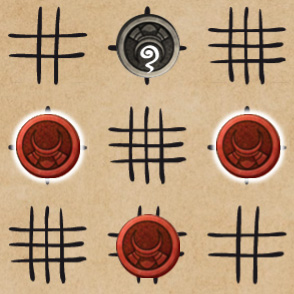 Early on in the iPad’s life, there was a game released called Scrabble. You may have heard of it. In addition to its expected lexicographic features was the ability to use iPhones and iPods as letter racks. A comic was made about this fact.
Early on in the iPad’s life, there was a game released called Scrabble. You may have heard of it. In addition to its expected lexicographic features was the ability to use iPhones and iPods as letter racks. A comic was made about this fact.There’s a kneejerk reflex to appeal to irony when discussing board games remade into video games, but the iPad might be the strongest case yet for doing so. Much of the appeal of board games is the fiddly bits — the tokens, pawns, and pieces that make board games what they are. When you bring a computer or a game console into the picture, it invariably brings about a disconnect. A controller divides you from the game's components. Even with all the Wiimotes, Moves, and Kinects being touted this recent holiday, each promising more immersion than ever before, there's still a real and tangible distance between you and the screen. Even the DS requires a stylus for practical playing.
The iPad is different. It’s physical. The large screen feels like a game board, with pieces that can be touched and slid around like checkers. Holochess it’s not, but it is a pleasant, intuitive experience, one with the advantages of both a real game and those of a computer. I think we can agree that having the game check the rules and score the moves for you is a good thing, and there’s no fighting over who has to return over-cramped components back to the box.
Classic games, the kind everyone has tucked away as part of a 5-in-one box and buried in the cavernous reaches of some closet or another, are a dime a dozen in the Apple App Store. Many Parker Bros. mainstays, like the aforementioned Scrabble, appear courtesy of EA, too. But as it is for other genres, the App Store is a robust habitat for indie board games, the sort with the designer’s name on the box and maybe a wooden person or two.
Mana HD is one of those. Created by French designer Claude Leroy, it’s a capture-your-opponent's-pieces game with a complexity somewhere between Checkers and Chess.
 Each player gets six pieces: a daimyo, the game’s king that you must protect, and 5 ronin, pawns to protect the daimyo. Anyone with a rudimentary knowledge of Japanese history will see a problem here, what with ronin being masterless samurai. But we’re talking about an abstract board game, so I guess holding it to a historical standard is unfair. It’s not like bishops rushed to the defense of their kings, either.
Each player gets six pieces: a daimyo, the game’s king that you must protect, and 5 ronin, pawns to protect the daimyo. Anyone with a rudimentary knowledge of Japanese history will see a problem here, what with ronin being masterless samurai. But we’re talking about an abstract board game, so I guess holding it to a historical standard is unfair. It’s not like bishops rushed to the defense of their kings, either.I digress. In short, the goal of the game is to capture your opponent’s daimyo while preventing the same.
Both players get to place their pieces within the closest two rows, but the red player always goes first and gets to rotate the board as seen fit. Whether this really provides any tactical advantage is up for debate, but there is a vague difference in the distribution of the game's three squares.
These squares form the crux of what makes the game unique. Instead of all pieces behaving the same way, as in checkers, or each uniquely, as in chess, the way your pieces move depends on two outside factors. The first is the space they rest on. Each square has anywhere from one to three hatch-marks on it. These marks equate to the number of spaces that piece can move — in a horizontal or vertical direction, never diagonally or passing over the same space twice.
 The second factor is the eponymous mana, and it's even more interesting. Once the red player moves a piece, that piece gets the mana. What does this mean? The black player may only move pieces that rest on a square with the same number of hatch-marks as that of the piece with mana. In turn, that black piece gets mana, and the red player is faced with the same limitation of choices. If ever the situation arises that a player has no pieces that match, they can move any one as they please or replace a fallen ronin.
The second factor is the eponymous mana, and it's even more interesting. Once the red player moves a piece, that piece gets the mana. What does this mean? The black player may only move pieces that rest on a square with the same number of hatch-marks as that of the piece with mana. In turn, that black piece gets mana, and the red player is faced with the same limitation of choices. If ever the situation arises that a player has no pieces that match, they can move any one as they please or replace a fallen ronin.While enticing your opponent into making certain moves is a mainstay of these sorts of games, the ability to actually decide which pieces are at the other player's disposal adds a layer of strategy that's novel and fun.
The presentation itself suits the elegant nature of the game, with graphics and sounds that are simple but beautifully evocative. The whole game hits those sort of notes. In a way, it’s much like the iPad itself.


